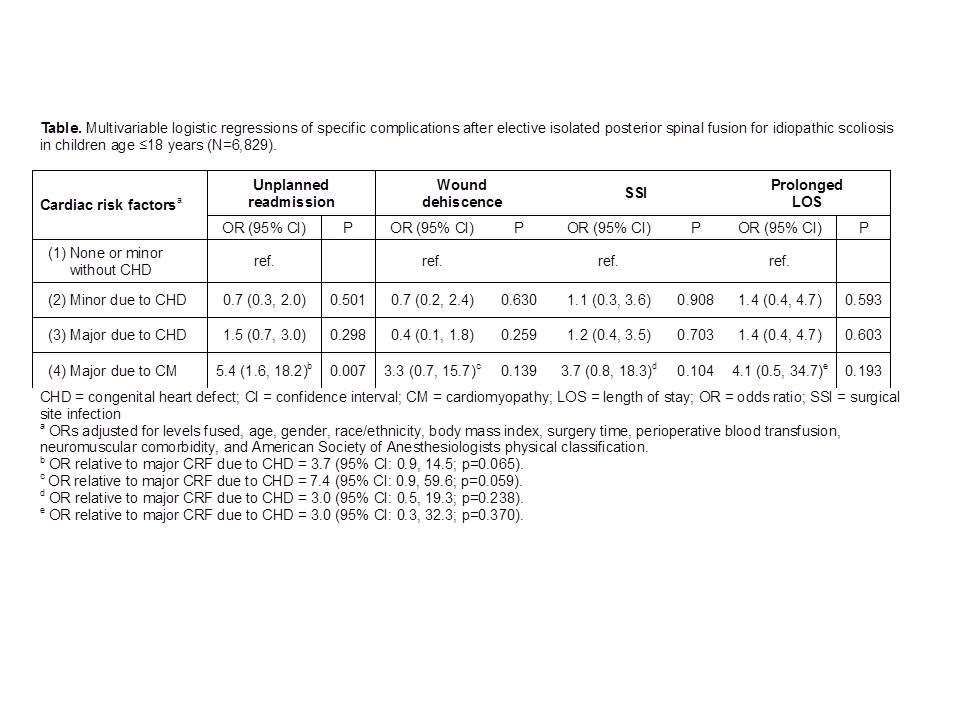GA1-55
Etiology of cardiac risk factors and complications after posterior spinal fusion for idiopathic scoliosis in children
McKee C, Martin D, Tumin D, Tobias J
Nationwide Childrens Hospital, Columbus, Ohio, USA
Background: Posterior spinal fusion (PSF) is performed to correct spinal deformities of idiopathic, neuromuscular, or congenital origin. While PSF is generally safe, cardiac comorbidities may increase the risk of complications. In previous studies, however, cardiac risk factors (CRFs) did not independently contribute to risk of complications after adjustment for patient and procedure characteristics. Differences in the risk of complications according to the etiology of cardiac disease are unclear. We used a national registry of pediatric surgical outcomes to evaluate outcomes of PSF according to presence of congenital heart defect (CHD) as compared to cardiomyopathy (CM).
Methods: Elective cases of isolated PSF for idiopathic scoliosis in patients 0-18 years of age were identified in the 2012-2015 National Surgical Quality Improvement Program-Pediatric. During primary data collection, trained coders abstracted CRFs as none, minor (e.g., well-controlled or repaired CHD), major, or severe (combined with major CRF for analysis due to small subgroup size). Using ICD-9 codes to determine the etiology of CRF, we classified patients as follows: (1) No CRF, or minor CRF without CHD; (2) minor CRF due to CHD; (3) major CRF due to CHD; and (4) major CRF due to CM. Multivariable logistic regression compared surgical site infection, wound dehiscence, hospital length of stay ≥30 days, unplanned readmission, and the presence of any of these complications across the four categories of CRF etiology and severity.
Results: The analysis included 5,274 girls and 1,667 boys, age 14±2 years. Among these, 140 had minor CRF due to CHD, 144 had major CRF due to CHD, and 20 had major CRF due to CM. Complication rates were higher among patients with CM (40%) than among patients with major CRF due to CHD (10%), minor CRF due to CHD (9%), or other minor or no CRF (5%; Chi-square p<0.001). In multivariable analysis, CM remained associated with increased odds of complications compared to no or minor CRF (OR=5.3; 95% CI: 1.8, 15.7; p=0.002), and compared to major CRF due to CHD (OR=4.5; 95% CI: 1.4, 15.0; p=0.014). When examining specific complication types, CM predicted greater odds of unplanned readmission (Table). In all multivariable analyses, CRFs due to CHD were not associated with increased complication risk.
Conclusions: CM is a rare but significant risk factor for complications after pediatric PSF, primarily due to unplanned readmission. Meanwhile, CHD does not appear to independently contribute to the risk of complications after this procedure.
References:
1. Berry JG, Glotzbecker M, Rodean J, Leahy I, Hall M, Ferrari L. Comorbidities and Complications of Spinal Fusion for Scoliosis. Pediatrics. 2017;139:e20162574.
2. Basques BA, Chung SH, Lukasiewicz AM, Webb ML, Samuel AM, Bohl DD, Smith BG, Grauer JN. Predicting Short-term Morbidity in Patients Undergoing Posterior Spinal Fusion for Neuromuscular Scoliosis. Spine 2015;40:1910-7.
Top












